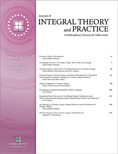 Kirsty Spence and Mark McDonald, Linking Developmental Action Logics to Transformational Leadership Behaviors, Journal of Integral Theory and Practice, December 2010.
Kirsty Spence and Mark McDonald, Linking Developmental Action Logics to Transformational Leadership Behaviors, Journal of Integral Theory and Practice, December 2010.
Aside from a couple of early articles of an introductory nature and Clint Fuhs integral examination of eight leadership books, articles on leadership in JITP have been rare. This should not be too surprising in that this journal addresses every possible field to which an integral approach or perspective might be applied. There was a special issue on integral coaching, guest edited by the founders of Integral Coaching in Canada (featured on the Integral Life website) and we should consider that quite relevant, particularly in the area of leader development.
Here we have two authors associated with sports management from Brock University in St. Catharines, Canada, in the case of Kirsty Spence and the University of Massachusetts in the case of Mark McDonald. Their positions is evidence of how the field of leadership studies lends itself so readily to an integral or transdisciplinary approach. Leadership as a field of study must address a wide range of variable, from the psychological to the behavioral to the culture to the systemic. It is concerned with the impact of political structures, economies, technologies and the widest range of phenomena in relation to leaders and leading.
Context is critical, as well. Leaders can be found in every conceivable type of organization and social system. We can find faculty interested in leadership in a wide range of academic departments from engineering to political science to history to sociology to sports management. And leaders are present in each of these departments, as well as every other in the academic panoply. Thus, the study of leadership calls for a transdisciplinary approach, drawing on the perspectives of virtually all fields of study. At the same time, despite notions of integral methodological pluralism and transdisciplinary approaches, including a more collective (multi-disciplinary) approach to research, most of our studies of leadership require sharper focus, partial treatments, attending to a limited set of variables. This is not a problem, but a recognition that as a field we learn from many more limited studies that ultimately can benefit from meta theoretical treatments. In the case of this treatment by Spence and McDonald we have a focus of models of adult development, particularly that of Loevinger/Cook-Greuter and Torbert [the Leadership Development Framework (LDF)], as related to James MacGregor Burns’ model of transformational leadership, particularly as extended by Bernard Bass.
Variables related to Bass’ approach include four skills of transformational leaders:
- IS: providing intellectual stimulation to others,
- IC: providing individualized consideration to others,
- IM: being inspirationally motivating, and
- II: providing idealized influence that builds trust and a sense of identity.
The authors then examine how each of these shows up in relation to leader profiles that show up as achiever, individualist and strategist. To do this kind of comparison it is essential to treat each of the four levels of development as archetypal. To do a more nuanced analysis that reflects how given individuals can show up to some degree in all of these levels of action logics with cognitive, operative and affective components, would require a much more detailed analysis that would be possible in a journal article. Perhaps we can hope the authors will undertake such a more nuanced analysis in the future.
In the meanwhile, we have this interesting exploration that suggests how the four I’s of Bass relate to the stages of development. For example, the Strategist shows a strong capability in each of the four I’s, as well as the relationships among them. On the other hand, the achiever who has strength in IM and II behaviors is less proficient in IS and IC behaviors.
One of the excellent features of this article is how the authors then apply a four quadrant integral framework to identifying some of the limitations of their work. For example, the authors state,
First, related to UL [Upper Left Quadrant—Ed.] inquiry itself, even though the LDF includes interconnected dimensions of cognitive, behavioral, and affective development, the model represents one line of ego development that highlights specific levels, each of which are characteristic of epistemologically different worldviews. As such, many other developmental lines (e.g., interpersonal, somatic, moral, spiritual, among others) inform one’s multiple intelligences, psychograph, or AQAL constellation.
Additionally, “we recognize that our conceptual analysis was made in isolation of the orienting truths representative of the other three AQAL quadrants.”
The authors include reflections on a case study published in 2007 of a Strategist leader. In particular they examine the limitations of that study through the AQAL lens. The strategist leader tended to give considerable autonomy to others; however, due at least in part to their own stage of development, this autonomy was perceived by some as neglect.
This focus on behaviors calls to mind a series of interviews I have been doing recently with CEOs and entrepreneurs who have experienced at least a year long training in integral leader development. The ways these individuals have used this learning is quite impressive to the point that they have demonstrated an understanding of themselves and of integral leader practices, as well as the effective implementation of these practices in a wide variety of ways. These practices range from self-managements skills, to reorientation toward a learning approach in their work and lives, to recognizing first tier worldviews and building the capacity to engage each.
I have no information on where these individuals would show up in the LDF. But what I am clear about is that taking an integral approach to developing leaders, including the development of skills related to a more integral practices, has been highly successful for these individuals, no matter what their mix in blue, orange or green and achiever, individualist or strategist.
Perhaps this leads us back to our challenge to develop clarity about our terms related to leadership, particularly from an integral perspective, as well as developing a more nuanced way of understanding how worldviews and action logics show up for individuals in varied contexts. One thing that has been virtually universally true for those I have been interviewing is that by learning integrally related practices they have made considerable changes in themselves, their roles in their companies and in relation to their families and personal lives. The interview with Laura Roberts in this issue is an example of this.
Studies and analyses such as those modeled by Spence and McDonald will help us build our understanding of integral leaders and integral leadership.
Prerna Centre of Learning Newsletter
http://www.prernacentre.com/web/newsletter.html
 Prerna is a Sanskrit term meaning inspiration. According to Anil Nayara, founder of the Centre, http://www.prernacentre.com/web/, it is “an institution set up to nurture and develop consciousness-centred leadership that, I believe, will help transform organizations and society to meet the challenges of the new millennium.” One of their services is a newsletter that features original articles, as well as republication of material by authors such as Otto Scharmer and Peter Senge.
Prerna is a Sanskrit term meaning inspiration. According to Anil Nayara, founder of the Centre, http://www.prernacentre.com/web/, it is “an institution set up to nurture and develop consciousness-centred leadership that, I believe, will help transform organizations and society to meet the challenges of the new millennium.” One of their services is a newsletter that features original articles, as well as republication of material by authors such as Otto Scharmer and Peter Senge.
Of greatest interest are the publications of articles by Indian authors. Examples of these include the following:
- Leaders Transform our Experience of Space-Time —Debashis Chatterjee
- Leadership by Intuition —Sraddhalu Ranade
- Re-inventing the Wheel—Ganesh Chidambarakrishnan
- Leadership Qualities—Partho
- Endearing is enduring…if you live it with a purpose—Vinit Taneja
- The Great and the Good: Leadership as if Humanity Mattered!—Shankar Venkataswaran
As an example, Venkataswaran’s article asks which institutions might support an approach to leadership that has a long-term perspective to address the many challenges facing the world today. He begins with the family. There, he states, “despite its imperfections, seems to have survived longer than most others.” Leadership is often “exercised collectively by parents who are expected to provide long-term benefits to all members.” Another institution with a long-term orientation is universities and their collegial model of leadership. Even corporations, for example oil and gas industry and financial, have a long-term perspective, according to the author.
He states further, “If Planet Earth and all its shareholders have to survive, leadership can no longer be a privilege that entitles one to personal glory but a responsibility to focus on the greater good and solving the problems of tomorrow.” Decision makers in all institutions need to challenge the business-as-usual approach. Citizens can hold the state accountable and “embrace the value of ‘enoughness’ by remembering Gandhiji’s words, ‘the earth has enough for everyone’s need but not for everyone’s greed!’”
Publications like this help to provide multi-cultural perspectives, not only on the challenges we face, but also on approaches to addressing them with the leadership capabilities we can muster.
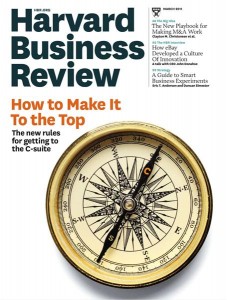 Boris Groysberg, L. Kevin Kelly, and Bryan MacDonald. “The New Path To the C-Suite,” Harvard Business Review, March 2011, pp.61-68.
Boris Groysberg, L. Kevin Kelly, and Bryan MacDonald. “The New Path To the C-Suite,” Harvard Business Review, March 2011, pp.61-68.
How one progresses up the corporate ladder varies by function, geography, industry and company. In their research the authors offer “One strikingly consistent finding: Once people reach the C-Suite, technical and functional expertise matters less than leadership skills and strong grasp of business fundamentals. Chief information officers need to know how to create business models; chief financial officers, how to develop risk management strategies” and so on. Increasingly these executives have more in common with each other than with the functions they oversee and manage. As such, they need to be original contributors to strategy and decision making.
The authors explore such functional roles as CIO, Chief Marketing and Sales Officer, CFO, General Counsel, Chief Supply-Chain-Management Officer, Chief Human Resource Officer and CEO. With regard to the latter they note some trends:
- CEOs less commonly select Board Members;
- CEOs increasingly owe their jobs to Boards;
- There is more accountability at the top;
- Boards are increasingly a source of CEO candidates.
And the skills that are increasingly cited as important are
- Strong communication [a perennial ambiguous favorite—Ed.]
- Empathy
- Collaboration
- Trust building
- Eliciting public trust as the face of the company, including “facility and credibility with socially responsible initiatives.”
The latter is of considerable interest because it suggests that there are institutional forces pressuring corporations to move toward social responsibility, including ecological correctness and, possibility, even conscious capitalism. I am aware of burgeoning interest among small to medium business CEOs and executives in the conscious capitalism movement. If the authors are right, there seems to be a high potential for that happening in larger corporations, as well. The likelihood is, however, in the monolithic global corporations that were will continue to be a great deal of lip service and symbolic activity without significance substance. Too cynical?
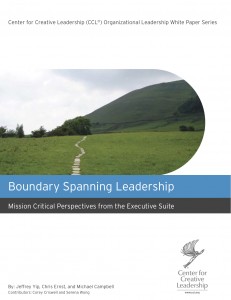 Boundary Spanning Leadership: Mission Critical Perspectives from the Executive Suite
Boundary Spanning Leadership: Mission Critical Perspectives from the Executive Suite
Center for Creative Leadership (CCL®) Organizational Leadership White Paper Series
Craig Appaneal, Kim Lafferty, and Sureish D. Nathan
One of the things we must appreciate about the not-for-profit Center for Creative Leadership is their persistent support for research. This has resulted in numerous influential academic papers and white papers being published. This white paper is a report on a survey of executives regarding the importance of boundary spanning skills.
“From 2008 to 2009, the Center for Creative Leadership surveyed 128 senior executives who participated in CCL’s Leadership at the Peak program. The executives served at the senior most levels of their organizations, with more than 15 years of management experience and responsibility for at least 500 people. This survey focuses on pressing trends and challenges affecting their organizations, and the role of leadership in spanning vertical, horizontal, stakeholder, demographic, and geographic boundaries.”
Because of the complexity in business today, those in leader roles need to be effective in managing and protecting boundaries, as well as integrating “direction, alignment, and commitment across boundaries in service of a higher vision or goal.” For example, economic, energy and innovation challenges involve working at “vertical, horizontal, stakeholder, demographic, and geographic boundaries.”
It is an important challenge to develop the capabilities of leaders at many levels of an organization to work at and across boundaries. “This capability resides within and across individuals, groups and teams, and larger organizations and systems.” This is particularly true in working across horizontal boundaries related to function and expertise.
Furthermore, in leader development, “A bottleneck is created when middle managers fail to make the shift from a bounded, within-group mindset to a boundary spanning, cross- group mindset.”
It seems that innovation has become an ever more important and key concern for many businesses, a strategic driver. The idea seems to be that innovation supports competitiveness, not just within an industry but globally. “This requires leaders to become more effective at spanning multiple boundaries—tapping into diverse expertise and cultural insights– to achieve breakthrough results.”
The paper also acknowledges that individual development must be accompanied by strategic and cultural development. What I found surprising about this report is that, despite some attention and interest in adult development models—particularly the work of Robert Kegan—the report does not address boundaries across action logics, worldview or ego and cognitive development. Now that would be a really interesting study.
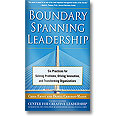 Chris Ernst and Donna Chrobot-Mason. Boundary Spanning Leadership: Six Practices for Solving Problems, Driving Innovation and Transforming Organizations. New York: McGraw-Hill, 2011.
Chris Ernst and Donna Chrobot-Mason. Boundary Spanning Leadership: Six Practices for Solving Problems, Driving Innovation and Transforming Organizations. New York: McGraw-Hill, 2011.
This book was published in partnership with the Center for Creative Leadership. One might assume that this is a new emphasis for leader development activities led by them around the world. In fact, this book grew out of the work of a study sponsored by the Center for Creative Leadership. Both authors hold positions with the Center for Creative Leadership.
Essentially the book is looking at the practices that are important for navigating the highly uncertain terrains of the contexts engaged in by organizations and their people. They focus on boundary spanning in two ways: “Boundaries may be borders that limit human potential, restrict creativity and innovation, and stifle necessary business and societal change. But boundaries also may represent frontiers: the location where the most advanced thinking and breakthrough possibilities reside.” The nature of leadership determines which of these are manifested, this :”shifting leadership landscape.”
The authors offer six practices for leading at the nexus between groups:
- Buffering
- Reflecting
- Connecting
- Miobilizing
- Weaving
- Transforming
They state, “Boundary spanning leadership is the ability to create direction, alignment and commitment across boundaries in service of a higher vision or goal.” Note the frame of reference here. Leadership is an ability. Apparently they see leadership as an individual ability, but nothing precludes it from also being treated as a collective ability. This is important in the face of complex challenges. The dilemma with tying “leadership” to an ability is that it seems to preclude other aspects of the leadership complex: issues of culture, systems, structure, roles, etc. Furthermore, it continues the “great leader” and “heroic” assumptions that continue to plague much of the leadership literature. But let’s look a little closer at what they are offering:
“In our research and practice at the Center for Creative Leadership (CCL), we define leadership in terms of accomplsihing three outcomes:
- Direction: a shared understanding of common goals and strategy.
- Alignment: the join coordination of resources and activities.
- Commitment: a commitment to collective success that is euqal to or about the commitment to the unique success of any single group.”
Six practices make up their model:
- Buffering: creating safety.
- Reflecting: fostering respect.
- Connecting: building trust
- Mobilizing: developing community
- Weaving: advancing interdependence
- Transforming: enabling reinvention
The reader can learn more about these in the book.
It is important to note that the level 0f analysis in this book is the team or group, particularly in working among groups, which requires boundary spanning activity. The use of the practices is oriented toward the management of boundaries (is that a leader role? It may be a manager role that supports the building of leader capabilities), forging common ground, and discovering new frontiers.
The fact is that these authors tell really wonderful stories about individuals who have successfully engaged boundary spanning activities in many different cultures. Like all good stories, they provide us with material to do our own reflection on regarding how we would approach the challenges and what our skills are in regard to different practices. What I find very interesting about the focus on individual capabilities is that it doesn’t matter if the primacy is given to a leader practice or a manager practice.
The very act of learning and developing one’s capacities can support each of us in being more effective, not matter what role we step into. Each occurrence may call for different roles; each occurrence may call for a different set of practices; each occurrence may see the leader role as dynamic, passing from one individual to another in the life of the system.
 A Special Report on Global Leaders, The Economist, January 20, 2011.
A Special Report on Global Leaders, The Economist, January 20, 2011.
This rep0ort begins with the story of a man who gets fired from his bank on Wall Street. He is 57 and feeling like a failure—despite the fact that he is quite wealthy. In order to escape the deriding glances of his apartment building doorman in Manhattan, he joined a self-help group for rich people, Tiger 21.It seems the members of this group gtive and work in charitable causes. The Economist labels these folks the “new elite.”
These are global leaders that we often do not hear about. They shape the world without being noticed. They are the individuals with “enough brains, money or influence to affect the lives of large numbers of others.” These elites are drawn on the basis of meritocracy and global connections. They are entrepreneurs whose ideas influence significant change a la Amnesty International and Facebook. The Economist is interested in how these folks wield influence.
The increasing disparity between this elite and the rest of us is built on a fragile foundation in capitalist democracies where consumer tastes can change rapidly, thus undermining the basis for influence of members of the elite. Nevertheless, these folks are increasingly a separate, insular group who inter marry and raise their children to continue in their footsteps (we know how challenging and fruitless such efforts often are).
In other economically rising countries, such as China, the elites play by different rules. They are dependent on the coercive power of the Chinese Communist Party. South Africa’s elite uses a system of residence permits to dictate how others live and work.
Nevertheless, “Rich folk affect the rest of us in two big ways. First, the way they spend their money has all kinds of ripple effects. Their hunches move markets. Their consumption supports a whole sub-economy of hoteliers, watchmakers and financial advisers. And their philanthropy funds schools, pressure groups and research into tropical diseases.
“The second, and more important, way is that to become rich int he first place, they typically have to do something extraordinary. some inherit their money, of course, but most build a better mousetrap, finance someone else’s good idea or at least run a chain of hairdressers in a way that keeps customers coming back. And because they are mostly self-made, today’s rich are restless, dynamic and much keener on change than the aristocrats of old.”
I think this means we are expected to be hopeful of a better future, thanks to this elite. We should do away with our cynicism about how many of these folks are stealing the very life from the rest of us.
 Justin Menkes. Better Under Pressure: How Great Leaders Bring Out the Best in Themselves and Others. Boston: Harvard Business Review Press, 2011.
Justin Menkes. Better Under Pressure: How Great Leaders Bring Out the Best in Themselves and Others. Boston: Harvard Business Review Press, 2011.
Anyone who has been reading Leadership Emerging for any length of time has probably gotten the message that I don’t think much of leadership “how to” books or advice giving. I do like books that offer ways for individuals to think about themselves and their own development, mental models of leadership, distinctions between leading, leader and leadership and the like. In other words, support for individuals to learn and develop is better than trying to mold people into images of some pseudo heroic individual in any context.
When I saw the title of this book I was prepared to toss it into the overflowing bin of advice givers and to some extent that might be justified. Or I would throw it into the bin of characterizations of “successful” business leaders. After all, the foundation of this book is interviews that the author has conducted for several years, as well as work he has done with these and/or other individuals in leader roles.
But here I find gems that have kept me from tossing it into these or any other bin; rather, it is now placed respectfully on the shelf of books whose authors are getting it as seen through my somewhat integrally informed lens. Note, for example, the two major learnings that have come from his study:
- “[L]eaders’ ability to realize their maximum potential and the potential of their workforce is the most profound way that they can differentiate themselves.”
- “[B]ecause the external environment around leadership has changed dramatically, how leaders realize their own and others’ potential has changed dramatically as well.”
He states, “Leadership means realizing potential—in yourself and in the people you lead.” This is a reciprocal relationship, that is, influence is at least bidirectional if not multidirectional in leadership occurrences. He indicates that leadership is a “fluid, virtuous cycle of exchange and growth between leaders and the people they lead.” I would modify this a bit to say that it is among those individuals and more.
Menkes then talks about attributes or catalysts required for effective leading:
- Realistic optimism
- Subservience to purpose
- Finding order in chaos
Of course. he falls readily into the trap of then talking about “great leaders.” Like most writers on leadership there is a manifested schizophrenia about the complex phenomena of leadership and the heroics of an individual leading in a temporary leader role. That aside, I have to say that this is a useful set of aspirations for any of us when attempting to move from a current state to a desired state, individually and/or organizationally. I have been struck by how CEOs I have been talking with have influenced their companies and led activities in relation to customers, for example, and held a clarified company purpose as the yardstick against which to measure the potential of a mutually profitable and successful business relationship. Menkes calls this “Affiliations Based on Shared Dedication.” Where this is lacking business relationship deteriorate.
He offers a way for the individual to assess the level of subservience to purpose by asking a series of questions related to a case study. He offers a new definition of loyalty: dedication and commitment is to the organization’s mission and purpose, not to other individuals. Such insights as he offers around this fill the book with truly useful material and recognizes that the answers to any challenges and questions must be placed in the context in which choice is made and action taken. Despite the understandable high esteem in which the author holds folks like Larry Bossidy and other CEOs, he is clear that he recognizes that these individuals a whole human beings who are not always heroic, not always effective, challenged as we all are to bringing our ways of making sense and meaning of the world into our choices about our own development and actions, as well as those of the institutions that create the contexts for our aspirations and activity.
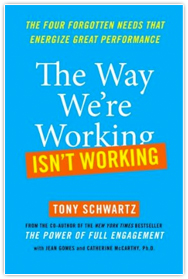 Tony Schwartz with Jean Gomes and Catherine McCarthy. The Way We’re Working Isn’t Working. New York: Free Press, 2010.
Tony Schwartz with Jean Gomes and Catherine McCarthy. The Way We’re Working Isn’t Working. New York: Free Press, 2010.
This book starts with a valuable premise: with the nature of the complexity of the demands facing us we require a multidisciplinary approach to support us. Multidisciplinary is good; it is a step toward transdisciplinary. The latter is an approach that would take into consideration not just dealing with “the four forgotten needs that energize great performance,” but also the implications of the cultures and systems that set the context for determining what is “great performance.” After all, it isn’t just about achieving any goal or ambition. It isn’t about making a company successful financially while off loading major costs to people and the environment for later generations to have to deal with. After all, the time between rip off and impact is getting shorter and shorter. Fortunately, Schwartz and his colleagues call attention to this.
In order to eke sanity (and higher productivity) in our work lives we must attend to four primary needs in these dimensions:
- Sustainability
- Security
- Self-expression
- Significance
“[S]ustainable great performance requires a rhythmic movement between activity7 and rest [and] it also depends on tapping multiple sources of energy:” physical, emotional, mental, and spiritual. What follows is a self-help book on taking care of yourself and your needs in the face of work structures and cultures, economic and political injustices, and the like. The particular needs have to do with you own physical health, management of stress, mental health and spiritual health.
Interestingly, phrases like realistic optimism (see other works reviewed in this column) also come up as they call for leaders to model attention to health and performance. An example is creating a culture that pulses. This involves shifting from an over focus on competency to more of a focus on capacity.They can do this by taking collective time for strategic thinking and relationship building.
They offer a new value proposition with the leader as “chief energy officer.” Terms relevant here include balance, accentuate the positive, “do no harm,” appreciate, value others. Spiritual rests on shared values and goals or purpose. The behavior of leaders is a statement of how these are served. so is how “leaders” treat their employees.
Sorry to be repetitive, but the perspective offered here is very conservative about how systems work. Leader=manager=power holder. I do not question the authors’ good intentions, but I do question building the world of work that they aspire to even on a multidisciplinary basis without attending to what has not been included.
.



Pingback: March 2011 Table of Contents